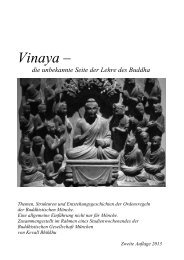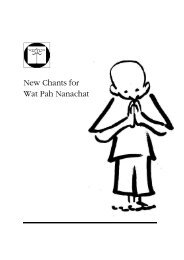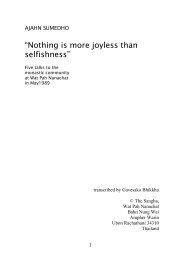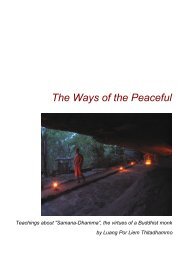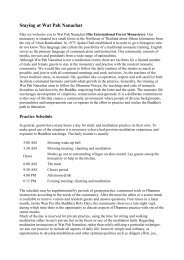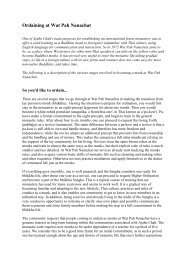Khanti - Wat Pah Nanachat
Khanti - Wat Pah Nanachat
Khanti - Wat Pah Nanachat
Create successful ePaper yourself
Turn your PDF publications into a flip-book with our unique Google optimized e-Paper software.
good or bad, nobody could take this away from me. I’d worn<br />
this robe at least once. Even if I was to have a heart attack on<br />
my way to the village or be bitten by a poisonous snake or fall<br />
into an elephant trap or whatever, my life hadn’t been in vain.<br />
Just getting this far was a wonderful achievement. I felt the<br />
most intense sense of good fortune. And that feeling has never<br />
left me. It might not always be so strong, it waxes and wanes,<br />
but it’s always there in the background of my mind. And for<br />
me it’s such an inspiring reflection that I’m wearing robes that<br />
don’t differ significantly from the robes worn by the Buddha<br />
himself, by Venerable Sariputta, by Venerable Moggalana and<br />
all the great disciples. And the way which all of us live our<br />
lives does not depart significantly from the way that Buddhist<br />
monks have lived for the past two thousand years. Yes, there<br />
are modern developments, and in certain ways life is more<br />
comfortable and convenient these days, but in the essentials<br />
there is a very strong sense of connection and lineage.<br />
The reason why this sense of lineage is so strong is, I<br />
think, more than anything else founded on our devotion to the<br />
Vinaya 2 . It is the Vinaya which distinguishes this community<br />
and monastic communities of this tradition from the lay world<br />
and from communities of lay meditators. Giving ourselves up<br />
to the Vinaya, devoting ourselves to this life, we tap into the<br />
incredible parami 3 that has been accumulated by Buddhist<br />
monastics since the time of the Buddha. And living the<br />
2 Vinaya: discipline; the Buddhist monastic code, the monk’s rules.<br />
3 parami: the spiritual potential accumulated through practicing<br />
specifically the ten perfections that the Bodhisatta achieved on his<br />
path to Buddhahood: dana (generosity, giving), sila (morality,<br />
virtuous conduct), nekkhamma, (renunciation), pañña (wisdom),<br />
viriya (energy, effort), khanti (patient endurance), sacca<br />
(truthfulness), adhitthana (resolution, determination), metta (loving<br />
friendliness), upekkha (equanimity).<br />
5



